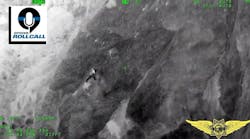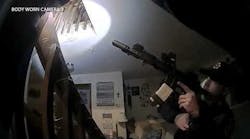Upon turnout, most police officers do at least a cursory check of their personal protective equipment. Among the items inspected include the firearm, non-lethal devices such as tasers, stun-guns, pepper spray and of course their bullet resistant vests. Sadly, the most recent additions to police officers protective equipment include protection against chemical and biological threats as well. Thankfully, most of these items are not used every day but when needed, they can be the difference between life and death. Airborne law enforcement flight crews are also equipped with their own unique personal protective equipment to protect them from a wide variety of airborne threats.
The Law Enforcement Aviators "Armor"
This past January, the world saw what could happen when a bird or birds get ingested into a passenger jet's engines. As US Air Flight 1549 glided to a landing in the Hudson River, the deadly threat posed by our feathered friends was thrust into the national spotlight. It should come as no surprise that bird strikes pose a very high hazard to law enforcement aircraft. Because of the mission profile, normally low and slow, precisely where most of the birds are, law enforcement aircraft and birds run a high risk of meeting under less than ideal conditions. The dangers of a bird strike are many; the aircraft could become catastrophically disabled or more commonly, the bird smashes through the windshield and can seriously injure the flight crew. There is another less known danger. Even if the bird smashing through the window does not cause an injury, the resulting carnage can be very distracting. Many flight crews that have experienced bird strikes through their windshields report that the smell of the bird is extremely overwhelming, almost to the point of incapacitating the crew. In order to prepare for this possibility, it is recommended that airborne law enforcement flight crews wear flight helmets that also provide eye protection. Should a seventy pound goose suddenly come crashing through the windshield, at least the head and eyes are protected. Helmets also provides head protection in a crash.
Most airborne law enforcement flight crews also wear a Nomex flight suit that provides limited protection in the event of a fire. These flight suits also have numerous pockets to carry all the aviation gear essential for the mission. Many aviators also wear a survival vest that provides a personal flotation device that could be inflated in the event of a water ditching. Usually contained within the vests are survival knives, signaling mirrors, strobe lights and in some cases a tracking beacon. These vests often have a secondary purpose; should the flight crew ditch, the vest can be hooked up to a cable lowered by a rescue helicopter and lift the aviator without any additional equipment needed. It is very similar to what our military fliers wear in combat.
A device that has become very popular in recent years is a very small underwater breathing device that provides, depending on numerous factors, a few minutes of air should an aircraft be ditched in water and the occupants need to escape from the aircraft. These devices closely resemble a SCUBA divers pony bottle that is used in emergencies.
Aircraft Ditching and Emergency Egress
Among the many types of training airborne law enforcement flight crews undergo is aircraft ditching and emergency evacuation training. Initial as well as recurrent classes are offered and highly recommended. Regardless of your comfort level in the water, there is always apprehension when a "dunker" drops you into a fifteen foot pool and flips over, with you strapped into your seat. If you recall the scene in the movie An Officer and a Gentleman in which a prospective Naval Aviator is dunked, you get the general idea. Your goal is an orderly and efficient escape. The first dunk is always the most intense. The apprehension slowly dissipates after each subsequent exercise.
A leading company in this training Survival Systems requires the aviator to complete at a minimum, five successful dunks and evacuations in order to be qualified. Some of the dunks are completed without supplementary breathing equipment. At least one of the dunks is done in complete darkness. Among the hardest evacuation exercises to complete is called the crossover in which the aviator has to cross over the cockpit to the other side of the aircraft and escape. Naturally, you have to wait for the other crew member to evacuate before you can cross over and evacuate. Seconds do seem like minutes! Most aviators reach a comfort level that permits them to finish as many as a dozen dunks. After this training, most aviators agree that they likely would not have been able to successfully evacuate their aircraft and take a much more serious look at aircraft ditching and safety.
Be Prepared!
Like their ground counterparts, airborne law enforcement officers must be prepared for a multitude of emergencies through equipment and training. Their protective equipment differs somewhat from the ground officer but the objective is exactly the same; to go home at the end of the day!


